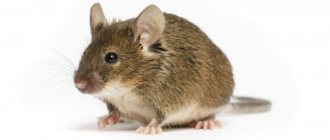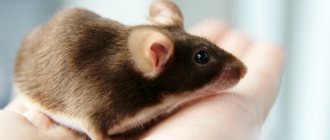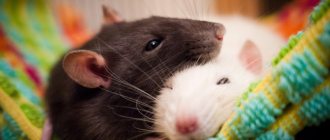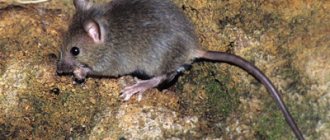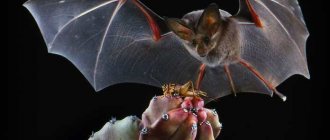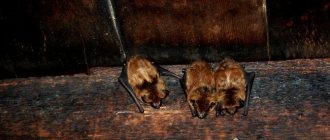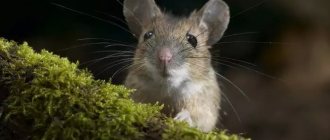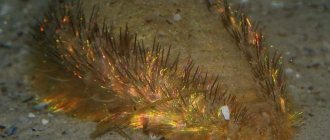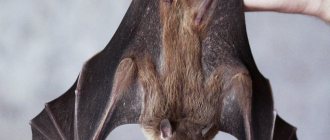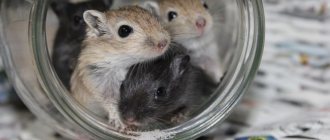Could this happen in a village house where there are a lot of rats? Or is it unlikely that they are afraid themselves?
Woman.ru experts
Find out the opinion of an expert on your topic
Larisa Evgenievna Mukhlynina
Psychologist, Supervisor, Gestalt therapist. Specialist from the site b17.ru
Semikolennykh Nadezhda Vladimirovna
Psychologist. Specialist from the site b17.ru
Tatiana Gokina
Psychologist, Clinical psychologist. Specialist from the site b17.ru
Egorova Anastasia Vladislavovna
Psychologist. Specialist from the site b17.ru
Tropina Natalya Vladimirovna
Psychotherapist. Specialist from the site b17.ru
Spiridonova Nadezhda Viktorovna
Psychologist. Specialist from the site b17.ru
Strazhkova Anzhelika Nikolaevna
Psychologist, Psychosomatologist Online consultant. Specialist from the site b17.ru
Lukashevskaya Natalya
Psychologist, PERSONAL AND FAMILY. Specialist from the site b17.ru
Korotina Svetlana Yurievna
Psychotherapist. Specialist from the site b17.ru
Zubkova Anna Andreevna
Psychologist, Gestalt therapist. Specialist from the site b17.ru
A mouse climbed on me in a dream, in my apartment!
A friend was bitten on the leg by a rat at night when she was sleeping at the dacha. Then she took rabies injections.
Generally easy! Rats love to eat human ears.
It’s just that a friend in a dorm lived in Moscow, and at night a rat climbed onto her face, her friend started guarding her with a bat and killed her
The author, as a person who has decorative rats, I can tell you that a rat can climb and fit anywhere) And while you are sleeping, they will not be particularly afraid, these are quite arrogant animals that are not afraid of anyone until they are offended.
Related topics
Maybe. I was sleeping with a cat at my grandmother’s in the village, and I woke up with a rat on my arm. And the cat was sleeping peacefully near my lap. The rat immediately ran away, of course. There were a lot of rats. The rats also brought me into bed, apparently during the day, a gnawed gingerbread. I went to bed and saw him near the wall on the bed. Once I went to the toilet, a rat from somewhere from the ceiling jumped onto my back and quickly ran away.
Maybe. I was sleeping with a cat at my grandmother’s in the village, and I woke up with a rat on my arm. And the cat was sleeping peacefully near my lap. The rat immediately ran away, of course. There were a lot of rats. The rats also brought me into bed, apparently during the day, a gnawed gingerbread. I went to bed and saw him near the wall on the bed. Once I went to the toilet, a rat from somewhere from the ceiling jumped onto my back and quickly ran away.
A mouse climbed on me in a dream, in my apartment!
Well, if they just walk over you in passing, if their path lies through your bed to the kitchen. And so they are unlikely to covet your ears
They can do something else. Once we had a decorative rat, but it ran away (while renovations were underway, there was no baseboard, the house was old) and lived under the floor or God knows where else. At night she ate the whole family, mother, father, younger sister, she was three years old at the time. One night she climbed onto my face, who the hell knows, was aiming to bite or kiss, but I woke up from the touch of her wet nose on my cheek. My goodness, I was so scared, I was in a state of passion. I hit her on the floor and she ran away. Then we nailed it. Now I can't even stand hamsters
Maybe it can bite too. Set up a rat trap
A decorative rat climbed onto my nose while I was sleeping, I was so pissed off that I gave it into good hands
They can not only climb in at night. But also to bite. Easily! In the mid-90s, the families of military personnel they knew were housed in barracks and two-hundred-year-old barracks. Where there were hordes of rats. Children suffered especially. They walked around bitten. One child's face was chewed off.
They can not only climb in at night. But also to bite. Easily! In the mid-90s, the families of military personnel they knew were housed in barracks and two-hundred-year-old barracks. Where there were hordes of rats. Children suffered especially. They walked around bitten. One child's face was chewed off.
The author, as a person who has decorative rats, I can tell you that a rat can climb and fit anywhere) And while you are sleeping, they will not be particularly afraid, these are quite arrogant animals that are not afraid of anyone until they are offended.
Maybe. I was sleeping with a cat at my grandmother’s in the village, and I woke up with a rat on my arm. And the cat was sleeping peacefully near my lap. The rat immediately ran away, of course. There were a lot of rats. The rats also brought me into bed, apparently during the day, a gnawed gingerbread. I went to bed and saw him near the wall on the bed. Once I went to the toilet, a rat from somewhere from the ceiling jumped onto my back and quickly ran away.
Well, if they just walk over you in passing, if their path lies through your bed to the kitchen. And so they are unlikely to covet your ears
Complaint
Moderator, please note that the text contains:
The complaint has been sent to the moderator
The page will close automatically after 5 seconds
Forum: lifestyle
New for today
Popular today
The user of the Woman.ru website understands and accepts that he is fully responsible for all materials partially or fully published by him using the Woman.ru service. The user of the Woman.ru website guarantees that the placement of materials submitted by him does not violate the rights of third parties (including, but not limited to copyrights), and does not damage their honor and dignity. The user of the Woman.ru site, by sending materials, is thereby interested in their publication on the site and expresses his consent to their further use by the editors of the Woman.ru site.
Habitat
The house mouse, the photo of which is presented in this article, is actually a wild animal. It got its name for living near humans. House mice live everywhere in the world, with the exception of permafrost areas, Antarctica and high mountains. The Latin name of the animal is Mus musculus, and a 3rd word is added to it, demonstrating the habitat area, for example, house mice that live in southeast Asia are Mus musculus castaneus. In our country, house mice also live almost everywhere: Krasnodar Territory, Rostov Region, Krasnoyarsk Territory, Astrakhan, etc. The only exceptions are the regions of the far north.
Lifestyle
The house mouse lives in various biotopes and landscapes, including anthropogenic landscapes. It is very closely associated with people and often inhabits outbuildings and residential buildings. In the north they carry out seasonal migrations. For example, at the end of summer, animals begin to move en masse to warm places: grain and vegetable storage facilities, residential buildings, and warehouses. The range of such migrations can reach 5 km. They often overwinter in stacks, stacks and forest belts. In the spring they leave their “winter apartments”, returning to gardens, orchards, and fields. In the south of the range they often live all year round without human habitation. In this place, house mice are attached to various reservoirs and oases.
In nature, they settle on not very dry, soft soils. There they dig small holes of simple construction. Inside they arrange bedding using soft plant rags. They often also occupy the burrows of other animals: mole voles, voles, gerbils, or use cracks in the ground and natural voids for housing. Settling near humans, they make their nests in the most protected and secluded corners, mainly under the floor, in attics, in heaps of household waste and garbage. In this case, any materials available to them are used for the nest: scraps of fabric, paper, feathers, wool, artificial fibers. House mice diligently maintain order in their nest. If the litter is heavily soiled, heavily infested with parasites, or gets wet, they simply leave the place, moving to some new place.
In nature, they are nocturnal and twilight animals, but in human habitation they adapt their daily routine to the life of people. Sometimes, under artificial lighting, they remain active around the clock, reducing it only during periods of active human activity. At the same time, the activity of animals is polyphasic; there are up to 20 periods of wakefulness per day, which last up to 90 minutes. Like many other mice, they adhere to constant specific routes when moving, creating noticeable paths with small piles of dust and droppings, held together by urine.
House mice are very nimble, active animals; They run, jump, climb, and even swim well. But they do not often move far from their nest. Each mouse in nature has an individual area: for males up to 1200 m2 and for females up to 900 m2. But at high population densities, animals settle in small family groups or colonies, consisting of a main male, several females with their children. Hierarchical relationships are always established among the members of this colony. Males are quite aggressive relative to each other, females show aggression much less often. Clashes within family groups are very rare; they mainly involve the expulsion of offspring who have already grown up.
Prevention
To avoid contracting infections and diseases from mice, follow these rules:
- wash your hands before eating, after any work, upon returning from the street
- wash vegetables and fruits thoroughly (you can pour boiling water over them, wash them with soap),
- do not eat foods that have traces of rodents (bitten bags of cereals, etc.),
- Store food in tightly closed containers and in places that are difficult for mice to reach. Uncollected food residues lead to the appearance of other parasites: cockroaches and ants.
In order to prevent the appearance of mice in the apartment:
- keep the apartment clean and tidy;
- Seal all cracks in the walls, ceiling, and under baseboards. A mouse can crawl through a very small hole and gnaw a hole even in concrete.
- Advice! It is recommended to seal the cracks with cement mixed with broken glass.
- Seal the water supply;
- get a cat.
Note! A cat can become infected with trichinosis, pick up ticks and fleas;
- install an electronic repeller. This small device is bought in a store. It is absolutely safe for humans and pets. The operating principle is based on electromagnetic pulses and ultrasonic waves, inaudible to humans, but which mice do not like and leave the apartment;
- Protect communication channels with metal grilles.
Description
House mice are long-tailed, small rodents with an oval-shaped body, small head, beady eyes and round ears. The tail is covered with sparse hairs and ring-shaped scales. Animals that live in nature have a zonal type of color, in this case the hair at the base of their tail is brownish-brown, the middle is fawn, and the tip is painted a pale gray shade. The abdomen is colored much lighter – to white. At the same time, decorative mice, which were bred by selective breeding, have a huge range of colors: black, white, blue-gray, yellow, as well as colors that combine several shades. White mice are albinos, since they practically do not synthesize melanin, which is responsible for the color of tissues. Breeders also bred tailless, long-haired, short-tailed, hairless, satin and curly mice.
Attitude towards children
They can be started in those families in which the children are 10 years old. They want to have their “own” animal, although they have no experience in caring for one. Many people are interested in the question: “Do house mice bite or not?” It is worth noting that they are not aggressive, although they can bite until they have had time to adapt to the owners and the environment, therefore, first it is necessary to help children get acquainted with the animal, as well as tame it. Very young children should not be left alone with these miniature, yet nimble and dexterous creatures.
Education
House mice are pets that are among the smartest animals among rodents, while decorative varieties quickly get used to their owners and are perfectly tamed if they are given enough attention, while speaking affectionately and softly. They are able to remember their nickname. Mice quickly begin to recognize the scent of the person who brings food, and will greet him with a cheerful squeak. Animals can be trained to respond to various whistles and various commands, for example, “Come to me!”, “Serve!”, “Home!”
It is worth noting that scientists have been studying house mice for a long time. Kotenkova E.V. (Doctor of Biological Sciences), for example, has devoted a lot of time to this issue, writing several scientific papers about their behavior, as well as their role in ancient mythology.
Specifics of the bite
A mouse's mouth is filled with all kinds of bacteria. Whatever the bite, microbes will certainly enter the puncture cavity.
There are several types of damage:
- superficial - the easiest, since the infection has not penetrated into the deep layers of the skin;
- partially torn layers of skin - the animal moved during the bite, the incisors cut off the top layer horizontally in a limited area;
- punctures - through holes, usually four. The animal's infected saliva enters the blood and human tissues. After a bite, deep wounds form from the sharp teeth of the rodent, usually bleeding. The edges of the wound quickly close.
The weak immunity of the bitten person provokes the development of the inflammatory process. Getting injured against the background of an ongoing illness is especially fraught with consequences. Children and the elderly are at high risk of infection if they are bitten by a mouse. What are the dangers of skin puncture?
Nutrition
House mice have a main diet of grains and seeds. They happily eat wheat, oats and millet, as well as unroasted pumpkin and sunflower seeds. They can also be given dairy products, white bread, pieces of egg white and cooked meat. The green parts of various plants can make up a third of the animal’s diet with a normal amount of water. At the same time, among succulent foods, mice prefer cabbage and dandelion leaves, slices of cucumber, beets and carrots, and green grass. Mice need up to three milliliters of water during the day. In summer they can feed on insects and their larvae. Mice have a very high metabolism, therefore, they should always have food in their feeder.
Maintenance and care
You can keep a mouse at home in a fine-mesh metal cage, as well as in a special organic glass container with a lid. It is necessary because mice are excellent jumpers. The terrarium or cage must be spacious enough, since animals are very active and need movement. Strips of unpainted paper or shavings are used as bedding. A house (a jar, a box, a pot, etc.) is installed in the cage, in which the mice will arrange a nest, a drinking bowl, a feeder, a piece of chalk, as well as other devices for games. Stairs, levels, shelters, branches are suitable for this; it is also advisable to install a running wheel.
The terrarium or cage is placed as far as possible from windows, radiators, air conditioners and doors, since animals do not like temperature fluctuations, direct sunlight and drafts. The best air temperature is 20°C with an air humidity of 55%. Every day, garbage and leftover food are removed from the cage, and the feeders and drinking bowl are washed. The bedding is changed three times a week, at least once a month it is necessary to disinfect and completely clean the terrarium or cage. Mice feces have an unpleasant, pungent odor. At the same time, females smell much weaker than males.
In the terrarium, it is advisable to install pieces of large tree branches directly with the bark (birch, willow, rowan) so that the animals can grind their incisors on them. It must be taken into account that lilac is poisonous to these animals. You can also put wooden toys in the cage, with which the animal will play, grinding down its incisors. With well-organized housing, house mice do not need walks. If the animal does go out for a walk, then the place for its walks must be limited to the owner’s hands or a table. It must be remembered that various house plants are poisonous to mice, including aralia, yucca, Christmas star, kala, etc.
When keeping several animals at once, it is advisable to create same-sex groups: 2-3 males or 2-3 females living in a common cage get along well together. At the same time, those that originated from the same brood get along better. Newborn babies should not be picked up and their mother should not be disturbed.
Such mice are evening and nocturnal animals; they can disturb sleep with the noise and various sounds they create, although they generally adapt to the human regime.
Rodent mesh
To protect a frame house from mice, a fine-mesh metal mesh is used. It is laid during construction and prevents mice from entering the home.
If the house has already been built, then the mesh can also be used by burying it underground near the concrete base; an earth mouse cannot crawl through the small cell.
Which mesh should I choose? Of course, metal, with small cells. It is necessary to make protection against mice at the construction stage of the building; such a device is laid under the insulation on the floor and on the walls. After installing such protection, you can even decorate your house with plasterboard.
Damage caused by mice
The destruction of such mice is caused by the damage they cause to human supplies, as well as equipment and household appliances.
Wild house mice, which have been fought by humans for centuries, are capable of eating almost anything. As a result, food, candles and soap, wiring, etc. become eaten away in the house.
Animals in warehouses gnaw grain, destroy crops of various root crops, eat cereal reserves, and, in addition, significantly pollute the house with the products of their vital activity. They actively excrete their waste, so even a small population can cause enormous harm. Thus, the animals do not eat the bulk of the grain, but rather pollute it.
In addition, house mice (we will learn how to get rid of them below) are carriers of a huge number of pathogens of various diseases. They can transmit E. coli, helminth eggs, and cause plague and typhoid fever to humans. They are often inhabited by blood-sucking insects, including fleas and ticks, which happily spread to humans.
Consequently, house mice can cause significant harm. Unfortunately, not everyone knows how to get rid of them. Professional extermination of animals is becoming the main activity for suburban areas, private homes, catering organizations, as well as various types of institutions. This service can be ordered from specialized companies, or you can use a mousetrap the old fashioned way.
Reasons for appearance
Mice enter the apartment from basements, garbage chutes, elevators and ventilation shafts. Sewage pipes are also used for transportation.
They can run away from neighbors.
Hiding in a box with a purchase from the store's warehouse, they move into an apartment.
Often mice are transported from the dacha in bags with the harvest.
Free access to products, when open bags and boxes of seeds, cereals and bread are stored openly on shelves, can attract the attention of rodents.
Mice can appear if the apartment is not cleaned regularly and garbage is stored at home for a long time.
Another reason for the appearance of rodents in an apartment is the onset of cold weather. Mice seek warmth, which leads them to heated rooms.
A little history
In nature, white albino mice are periodically born, and it is almost impossible for them to survive, since they are very noticeable and also instantly become prey. But in ancient times in Crete they were kept in the form of living amulets that bring good luck. They were also kept in temples, where they were specially looked after by ministers. 4,000 years ago, mice were bred and kept in Ancient Egypt, paying close attention to colored species. The Egyptians attributed supernatural abilities to them, and also depicted them on their clay vessels.
During the period of Ancient Rome and in the Middle Ages, healers used mice and rats for medicinal potions, while in Asia they are still specially bred for such purposes. With the development of veterinary medicine and experimental medicine, mice and rats began to be used for various studies as laboratory animals. It is believed that decorative and laboratory mice originate from white, spotted and black fighting mice, described in a book published in 1787. It talks about the animals that were used for fighting at that time. English merchants brought them from Japan. Subsequently, the mice formed a special line of house mice, and decorative breeds began to be bred as pets.
Today, in various countries of Western Europe and America, there are Clubs for mouse lovers, the main goal of which is to breed new varieties of these animals. Most often, individuals of different colors are obtained: gray, white, red, brown, lilac or pinkish, with spots. Special exhibitions with expert assessments are held there.
But in our country, decorative mice are less known than in America and Europe, but among animal fans they are becoming more and more popular every year. In clubs for lovers of various rodents, special sections of ornamental mice have been created, nurseries have been opened that engage in selection and breeding work, and exhibitions are also held where house ornamental mice are exhibited along with other small animals.
Treatment of the wound
For any injury, it is important to thoroughly rinse the wound to remove as many pathogenic microbes as possible with running water. Before the procedure, you should squeeze out a little blood from the wound; along with it, some of the infected rodent saliva will flow out.
Washing the wound is most effective when using laundry soap. The alkali in the product neutralizes the effects of many viruses and bacteria. It is recommended to clean the wound for 15-20 minutes. Deep punctures should be washed with a stream of soapy water using a syringe or syringe.
Superficial scratches and wound edges should be disinfected with 3% hydrogen peroxide or any alcohol solution. After treatment, all that remains is to stick a patch on the damaged area or bandage the wounded area with a sterile bandage with an antiseptic (furacilin).
There is a misconception about the destruction of viruses by cauterizing the bite site. This procedure is painful and does not remove the infection from the wound. The victim receives additional injury in the form of a burn.
When treating a mouse bite, special attention should be paid to people prone to severe allergic manifestations.
A foreign protein that enters the body can cause severe symptoms of irritation:
- swelling of the injury site;
- severe redness of the bite;
- skin rash.
Taking an antihistamine will prevent the body’s protest reaction and improve the victim’s well-being.
Proper first aid reduces the risk of infection and the development of an inflammatory process. But thorough infection prevention is only possible in a medical facility.
